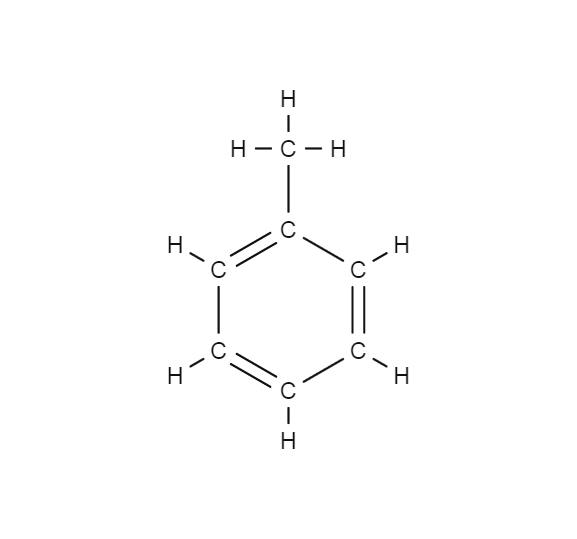
Toluene
- C7H8
- CAS Number 108-88-3
- UN1294 (gas)
Click & drag to move the 3D molecule
Liquid / Gas Volumes
Calculate the volume or mass of a quantity of gas or liquid
Liquid Phase
At boiling point at 1.013 bar
Gas Phase
In standard conditions (1.013 bar, 15°C)
Physical Properties
Molecule phase diagram showing the transition phases between solid, liquid and gas as a function of temperature and pressure
-
- Molar mass 92.138 g/mol
- Content in dry air /
-
Critical Point
- Temperature 318.60 °C
- Pressure 41.263 bar
- Density 291.99 kg/m³
-
Triple Point
- Temperature -95.15 °C
- Pressure 3.939E-7 bar
Pressure 1.013 bar
| Latent heat of fusion (at melting point) | 72.022 kJ/kg |
| Melting point | - 94.97 °C |
Pressure 1.013 bar
| Boiling point | 110.6 °C |
| Latent heat of vaporization (at boiling point) | 360.696 kJ/kg |
| Liquid density (at boiling point) | 779.14 kg/m3 |
Applications
Examples of uses of this molecule in Industry and Healthcare
Safety & Compatibility
GHS02
Flammable
GHS07
Health hazards
GHS08
Serious health hazard
Autoignition Temperature, Flammability Limits & Flash Point
Europe (according to EN1839 for Limits and EN 14522 for autoignition temperature)
| Autoignition temperature (Chemsafe) | 535 °C |
| Flash point (Chemsafe) | 6 °C |
| Lower flammability limit (IEC 80079-20-1) | 1 vol% |
| Upper flammability limit (IEC 80079-20-1) | 7.8 vol% |
US (according to ASTM E681 for Limits and ASTM E659 for autoignition temperature)
| Autoignition temperature (NFPA 325) | 480 °C |
| Flash point (NPFA 325) | 4 °C |
| Lower flammability limit (NFPA 325) | 1.1 vol% |
| Upper flammability limit (NFPA 325) | 7.1 vol% |
Threshold of toxicity
| ILV-15min EU (at Patm and 293.15 K) | 384 mg/m3 or 100 ppm |
| ILV-8h EU (at Patm and 293.15 K) | 192 mg/m3 or 50 ppm |
| PEL USA OSHA (vol) | 200 ppm |
| VLEP 8h France (at Patm and 293.15 K) | 76.8 mg/m3 or 20 ppm |
| VLEP CT France (at Patm and 293.15 K) | 384 mg/m3 or 100 ppm |
Odor
Like solvent for paint
Metals
| Aluminium | No data |
| Brass | No data |
| Monel | No data |
| Copper | No data |
| Ferritic Steel | No data |
| Stainless steel | No data |
| Zinc | No data |
| Titanium | No data |
Plastics
| Polytetrafluoroethylene | No data |
| Polychlorotrifluoroethylene | No data |
| Polyvinylidene fluoride | No data |
| Polyvinyl chloride | No data |
| Ethylene tetrafluoroethylene | No data |
| Polycarbonate | No data |
| Polyamide | No data |
| Polypropylene | No data |
Elastomers
| Butyl (isobutene- isoprene) rubber | No data |
| Nitrile rubber | No data |
| Chloroprene | No data |
| Chlorofluorocarbons | No data |
| Silicone | No data |
| Perfluoroelastomers | No data |
| Fluoroelastomers | No data |
| Neoprene | No data |
| Polyurethane | No data |
| Ethylene-Propylene | No data |
Lubricants
| Hydrocarbon based lubricant | No data |
| Fluorocarbon based lubricant | No data |
Materials compatibility
Learn More
More information
Its synthesis was discovered by Rudolf Fittig. Its name was derived from the older name "toluol", which refers to tolu balsam, an aromatic extract from the tropical tree Myroxylon balsamum, from which it was first isolated.